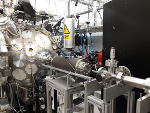LhARA ionacoustic dose profiling meeting: 01Sep21; 09:00 BST
Notes
JM 08/09/2021
Present: Ben Cox, Ken Long, John Matheson, Colin Whyte
Discussion
Ken reported that Emma Harris is interested in taking on the role of supporting Jeff. Ken will circulate the long version of the previous proposal.
Ben led a discussion of his concerns about the approach of designing transducer arrangements for the different stages of the work (proof of principle, Stage 1, Stage 2). The range of the protons is critical and this can be addressed with a single on-axis transducer, beyond the proton range. Previous discussions have included arrays of transducers arranged in rings and hemispheres which could cost 10s to 100s x £1K. The minimal solution is a single transducer, as described, at a few x £1K. It was agreed that Jason should be asked what he considers desirable in terms of complexity, bearing in mind that we may not have the funding to do everything that we would like. We should not forget the aim of being able to address the measurement of microbeams, etc. which may need more complicated arrangements.
Ben was concerned about historic difficulties with predicting acoustic signals from first principles and designing sensors to match. The literature gives information on what has been successful and we should scale from known experimental data. The aim would be to approach CERN (or other test beam location) and be able to ask for the beam properties that we need (energy, bunch length, time structure, transverse dimensions….). The acoustic pressure at the transducers will be maximised in the stress confinement regime, i.e. the energy of an incoming bunch should be deposited in a time which is smaller than the Bragg peak width divided by the speed of sound in water. We need to get the transducers as close as reasonably practical to the Bragg peak itself, to maximise the signal.
Long term we need to do full simulations of possible array layouts and include the necessary aspects of engineering design – e.g. we will likely need water to be added to cell culture flasks for coupling and we may get unwanted acoustic reflections off the surroundings, particularly at Stage 1 where small flasks containing cell cultures could be used.
It was agreed that that we have enough pictures and other material in hand or easily developed, to make a sound case to a funding agency to be supported to take things further. The existing simulation results could be scaled by experimental results from the literature to estimate the necessary transducer sensitivity for each set of beam parameters (BC, KL). IMASONIC will be able to advise on transducer design and costs.
Actions:
KL – prepare a slide on the likely timeline of the ion acoustic imaging work package
KL – circulate long version of GC proposal, send picture of cell sample container arrangement to BC
JG – circulate literature on existing lab ion acoustic imaging setups
JM – chase Fergus Wilson
Agenda
- Introduction, notes and actions of previous meeting: All
Actions:- KL – circulate long version of GC proposal
- JG – circulate literature on existing lab ion acoustic imaging setups
- KL, BC meet to discuss putting the parts of the simulation together to get the acoustic pressure for the low energy beam
- JM, KL meet at RAL to discuss taking forward the SmartPhantom. JM talk to Liam Cooper, Fergus Wilson.
- JB to connect KL with Emma Harris and prepare some slides for next week if possible
- Discussion
- AOB: All
